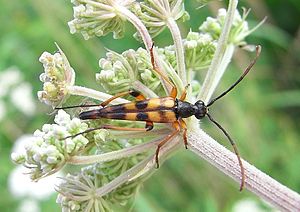Strangalia attenuata
| Strangalia attenuata | ||||||||||||
|---|---|---|---|---|---|---|---|---|---|---|---|---|

Strangalia attenuata |
||||||||||||
| Systematics | ||||||||||||
|
||||||||||||
| Scientific name | ||||||||||||
| Strangalia attenuata | ||||||||||||
| ( Linnaeus , 1758) |
Strangalia attenuata is a beetle from the family of the longhorn beetle and the subfamily narrow bucks . Synonyms are Strangalina attenuata and Typocerus attenuata . The first description was under the name Leptura attenuata .
Already the subfamily "Schmalböck" is named after the slim physique (leptos = λεπτός (Gr.) = Slim). The species name attenuata emphasizes that the animal is built very narrow (attenuo P. (Latin) = to become thin).
Characteristics of the beetle
The body is very narrow, especially in the male, and narrows even more towards the rear. It reaches a length of nine to seventeen millimeters. The color impression is determined by the red, yellow and black banded wing covers.
The head is elongated (Fig. 4) and sloping downwards. The large, domed compound eyes are clearly spaced from the base of the upper jaw. Behind the eyes, the head narrows to a distinct neck. The eyes are only slightly outlined at the antenna base (Fig. 4). The eleven-link filiform antennae are black in the first half and brownish at the end. They arise between the eyes. The last five antennae segments have a flat, matt pit on the outside in front of the end, which is particularly well developed in the males (Fig. 5).
The pronotum is black like the head. Its rear angles are pointed.
The narrow elytra are drawn very variably, in principle they show four transverse bands on a red-yellow background. A narrower transverse band runs behind the shoulders, in the middle of the wing there is a wide band that is expanded to a large spot on each wing, another wide band runs in the last third of the wing and the tips of the wings are also darkened. At the tip, the wing covers are cut off and slightly bulged (Fig. 3).
The abdomen segments are whole in the male and partly brown-yellow in the female. The legs are mostly red-yellow, the individual limbs more or less darkened at the ends. The front hips are conical (Fig. 2). The five-limbed tarsi appear four-limbed (pseudotetrameric), since the fourth limb is very small and hidden between the lobes of the third limb.
 Fig. 1: Side view Fig. 2: Underside Fig. 3: Top of the wing cover   |
 Fig. 4: Head from the front Fig. 5: Feeler links 7–10 arrows point to pits  |
biology
The larva develops in a variety of different deciduous trees, often in old oaks . It takes 2 years to do this, and more in the north. The adult beetle can be found in summer mainly on flowers, often on umbellifers .
distribution
The distribution area stretches from southern Europe to southern northern Europe, but the beetle is becoming increasingly rare towards the north. It also occurs to the east as far as Iran . The species is absent in Portugal , on the islands of Sicily , Sardinia , Crete and Cyprus , as well as in Great Britain and Ireland .
Individual evidence
- ↑ a b Strangalia attenuata in Fauna Europaea. Retrieved on December 18, 2010
literature
- Heinz joy, Karl Wilhelm Harde, Gustav Adolf Lohse (ed.): The beetles of Central Europe . tape 9 . Cerambycidae Chrysomelidae . Spektrum Akademischer Verlag, Munich 1999, ISBN 3-8274-0683-8 (first edition: Goecke & Evers, Krefeld 1966).
- Adolf Horion: Faunistics of the Central European Beetles, Bd. XII . Überlingen-Bodensee 1974